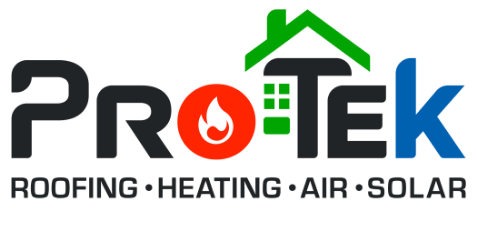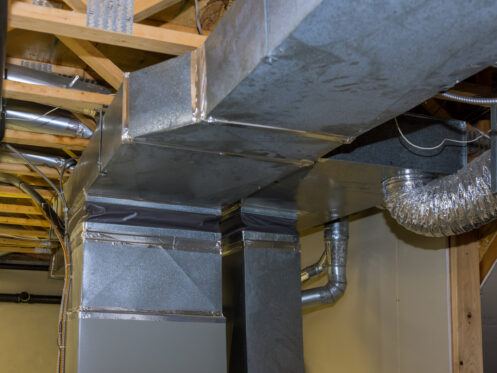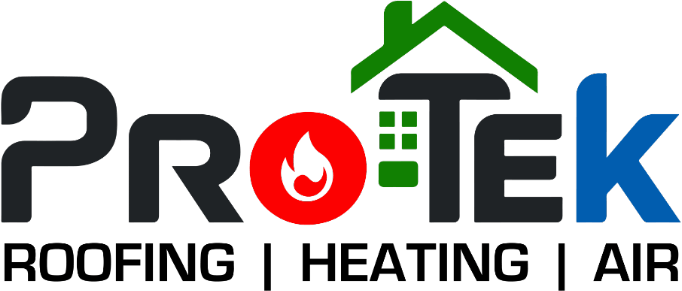If you need to replace the ductwork in your home or you’re building a new home, you should think carefully about what type of ductwork you want to use. There are four main types of ductwork commonly used in HVAC systems: sheet metal ducts, flexible ducts, fiberboard ducts and fiberglass ductboard. The type of ductwork you choose will affect how much the project costs and can also have an impact on the effectiveness of your HVAC system and the air quality in your home. For these reasons, it’s important that you understand the pros and cons of each option to help you determine which one is the best choice.
Sheet Metal Ducts
Sheet metal ducts are the most common type. In the majority of homes and businesses in the US, most or all of the air ducts are built out of aluminum or galvanized steel sheet metal. Sheet metal ductwork is constructed by cutting and bending individual pieces of metal to create each duct branch. All of the branches are then installed and joined together, and then each joint is fully sealed with foil tape or mastic to ensure the entire system is airtight and doesn’t leak.
Sheet metal is one of the most expensive ductwork options. All of the ducts are usually built in a sheet metal shop and then delivered to the site for the technicians to install. This means that sheet metal ductwork takes more time to build and install since the other options can typically be built on-site.
The only other real drawback to sheet metal is that it is a poor insulator. If you have sheet metal ductwork in an unconditioned area like an attic or crawl space, the outside of all of the ducts needs to be wrapped with insulation. If not, the sheet metal will absorb lots of heat in the summer and cold in the winter, which will make your HVAC system much less effective and lead to it using much more energy.
Despite the higher cost, sheet metal has numerous advantages over the other types of ductwork that typically make it the best option. Sheet metal ducts are extremely durable, as the metal used to build the ducts is fairly thick. This makes sheet metal ducts less prone to damage and leaks compared to the other options. The smooth metal surface also allows air to easily flow through the ductwork, which helps to improve the effectiveness and energy efficiency of the heating and air conditioning system.
Sheet metal is also non-porous, which makes it less prone to mold growth than other ductwork options. Any type of ductwork will collect dirt and other debris over time and should be professionally cleaned every few years. However, sheet metal ducts tend to collect less dust and are much easier to clean than the other options.
Flexible Ducts
Flexible or flex ducts are made of a coiled metal wire that is coated in a thick sheet of flexible plastic. It is extremely rare for all of the ductwork in a home to be made from flex duct, as at least the supply and return plenums that connect to the air handler and furnace need to be made from some type of rigid duct material.
Flexible ductwork is most commonly used for things like exhaust vents and attic fans. It can also be used for normal air ducts, but this is typically only ever done in situations where there isn’t sufficient room to install rigid ducts. If you’re installing something like a whole-home air filter or air purification system onto your HVAC system, flex ducts will typically also be used to connect it to your existing duct system.
Flexible ducts are the cheapest option and the easiest to install. However, they are also prone to sagging and kinking, which can interfere with airflow and make the HVAC system much less effective and less energy efficient. It is also extremely easy to puncture the plastic coating on flex ducts, which means they are also more prone to leaking than rigid ducts.
Fiberboard Ducts
Fiberboard ducts are made of stands of fiberglass that are embedded within a special resin. The outside of the ducts is also covered with foil that acts as a moisture and air barrier and helps to keep the duct better insulated. The inside of the ducts also has a special coating that fully seals the fiberboard to prevent any of the fiberglass strands from circulating in the air.
Fiberboard ducts are quickly becoming one of the most popular options and have a number of advantages over sheet metal. One major advantage is that fiberboard ducts are much better insulated to prevent heat loss and heat gain as the air flows through the ductwork. The insulation also has acoustic properties, which means it limits the amount of noise you hear when the HVAC system is running. This noise reduction is why fiberboard is so popular for commercial and industrial buildings.
Fiberboard is also less expensive and easier to install compared to sheet metal. Fiberboard ducts can easily be fabricated and the sheets cut to fit smaller areas or places where it would be difficult to install other types of ductwork.
The biggest issue with fiberboard is that the inside surfaces of the ducts are somewhat rough. This means that fiberboard ducts will trap much more dust and debris, which can negatively impact indoor air quality. Fiberboard ducts are also much more difficult to clean compared to sheet metal. The rough surface also creates more airflow resistance, which can make the HVAC system somewhat less effective. Fiberboard ducts are also much more prone to mold and mildew growth, which means they’re generally not recommended for use in humid climates.
Fiberglass Ductboard
Fiberglass ductboard consists of standard sheet metal ducts that have a fiberglass lining that serves as an extra layer of insulation and also helps to dampen noise. The lining also helps to prevent condensation from forming on the inside and outside of the ducts. Fiberglass ductboard tends to be the most expensive option. It is most commonly used in cold climates, as it is better at preventing heat loss compared to the other options.
The biggest problem is that this type of duct is that it tends to trap lots of dust, allergens and bacteria. This means it will need to be cleaned more often, and it is also much more difficult to clean than any other option. Another issue is that fiberglass ductboard doesn’t last as long. If not replaced soon enough, the fiberglass will start to deteriorate and release lots of particles into the air. This is a major health concern since exposure to fiberglass can irritate your eyes, skin, throat and lungs, and some studies have also linked fiberglass to an increased risk of lung cancer.
If you need any ductwork services in the Tampa area, Protek Roofing, Heating, Air & Solar is here to help. We specialize in ductwork inspections, installation and repairs, and we also offer professional air duct cleaning. Our expert team can also help if you need any other HVAC, roofing or solar power service. For more information on your options for ductwork installation or replacement, give us a call today.




